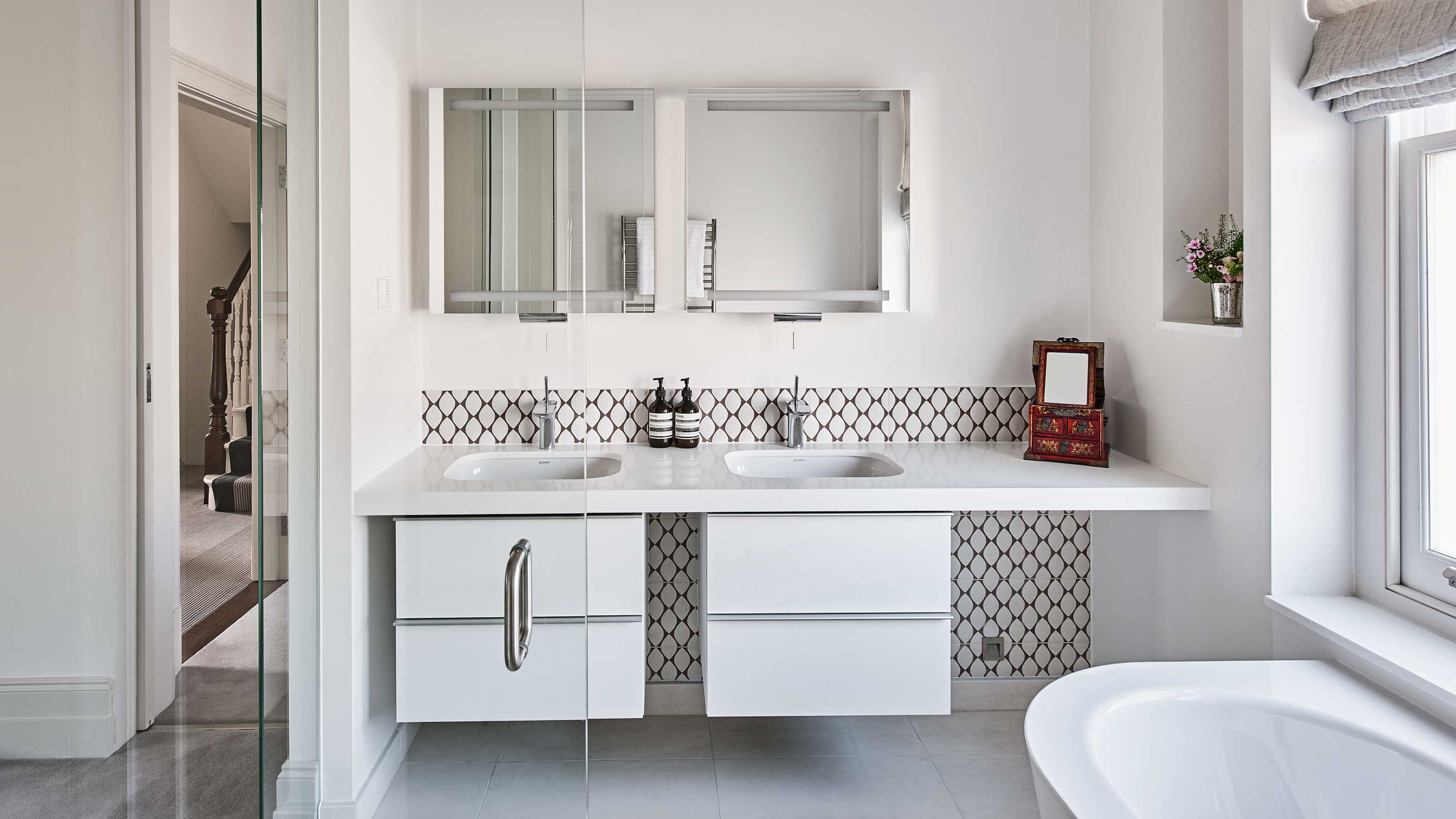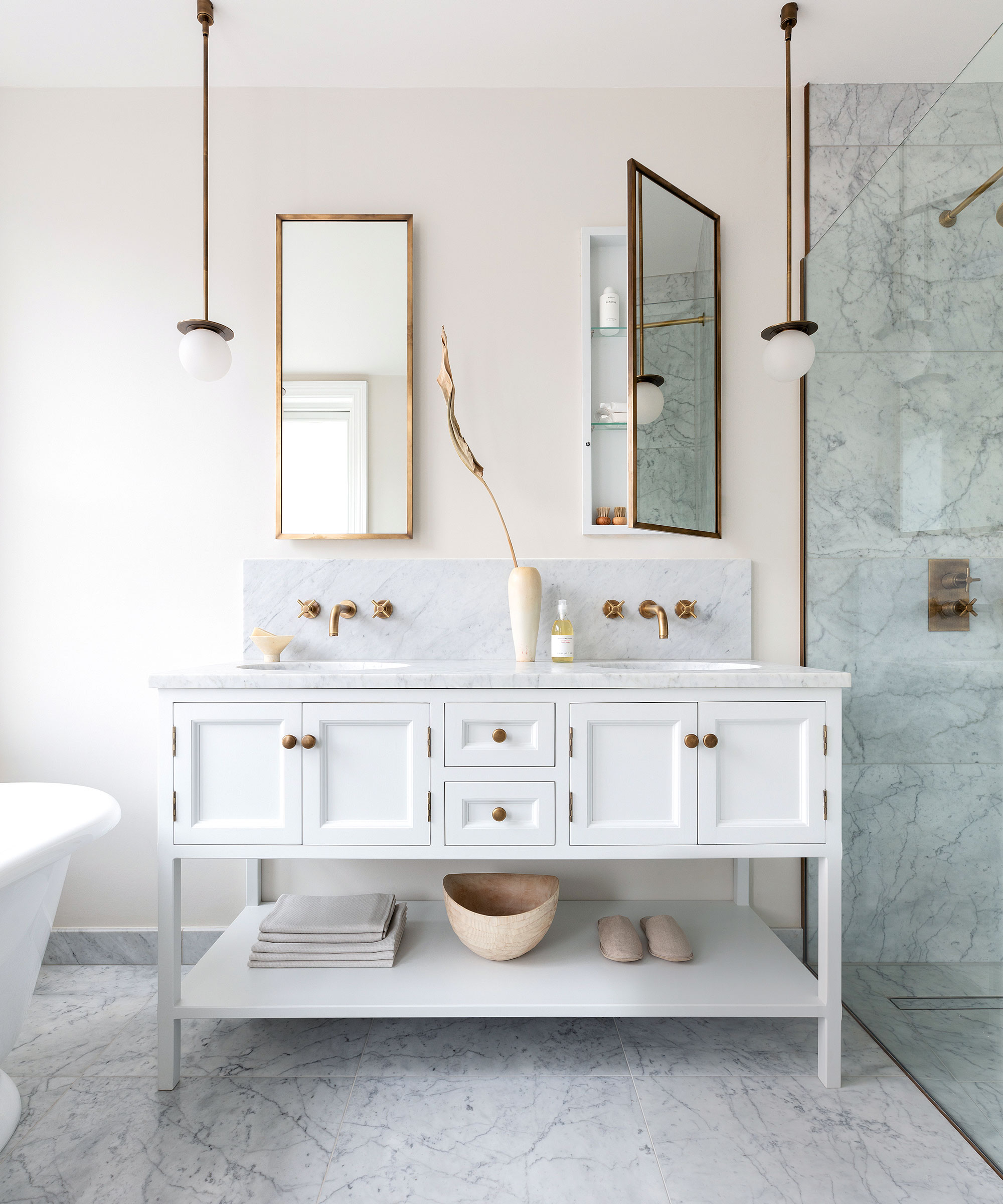Professional home organizers say this is how to create an effective bathroom overflow
For those of us who can't help but have too many toiletries and hair products


Bathrooms are one of the most used rooms in the entire home. We rely on these spaces to wash, freshen up, and store our essentials including toiletries, towels, and medicine. Over time, we purchase and collect more things, so it can really help to have some kind of 'bathroom overflow' system.
Creating an effective storage system for your regularly used bathroom supplies can be a game-changing step when organizing a bathroom. Having an organized bathroom will completely transform the space, whether you have a small bathroom or not, freeing up unused space and preventing you from making those bathroom organizing mistakes again.
Our experts have shared their insights so that you can organize your bathroom in an efficient way so that even when you are in a hurry, these spaces are functional and can be kept neat and tidy at all times.
How to organize your extra bathroom supplies
We’ve asked our experts for their organization methods to help create a step-by-step guide for organizing and storing your bathroom back-stock.
1. Use your under-sink storage properly

When creating an effective overflow system it is important that you dedicate an area to it. The space beneath the bathroom sink is often underutilized and is a great place to store your bathroom overflow supplies. Reasons for this may be due to prioritizing other storage containers and bathroom cabinets or simply not wanting to store toiletries and personal items near pipes and at potential risk of water damage.
‘In order to maximize storage for your surplus supplies, and not use up your bathroom closet or cabinet space, utilize the space beneath your sink,’ says Kirsten Fisher, founder and CEO of Imagine Home Organization. ‘Under the sink is an ideal spot for storing your extra toiletries, and linens. The important thing is to have a designated space where you can store overflow items without cluttering up your bathroom.’

In addition to running her own professional organization company Kirsten Fisher is also a Certified Professional Organizer, a member of the National Association of Professional Organizers and National Association of Specialty Move Managers.
2. Declutter and dispose
According to cleaning expert Prerna Jain, the first step in creating a manageable and effective storage and organization system is to declutter your supplies and dispose of any that need to go.
Design expertise in your inbox – from inspiring decorating ideas and beautiful celebrity homes to practical gardening advice and shopping round-ups.
Over time, bathrooms can accumulate an excess of products and there are many instances where items are no longer needed. Dispose of expired supplies such as toiletries, makeup, or medications.
Once organized, you can then establish a routine of decluttering and maintaining your bathroom. Regularly assess your toiletries and unused items, and discard or donate them accordingly. This practice will help you keep your bathroom neat and prevent additional overflow.

Prerna Jain is the founder of Ministry Of Cleaning, a top-rated cleaning service with years of industry experience.
3. Invest in smart storage solutions

One of the key methods to create an effective overflow system in the bathroom is by implementing smart bathroom storage solutions. These can help you maximize vertical space and provide designated spots for toiletries, towels, and other essentials.
Consider installing additional shelving units or wall-mounted organizers. Back-up products you know you'll use can be stored on the back of the bathroom door using this Elfa Door rack from Amazon with large baskets. These add so much additional storage space and don't take up any additional bathroom space.
You can usually add a few shelves over your toilet. Be careful not to put them too low or you will hit your head when you use the bathroom. You can use open shelving with baskets to keep it tidy or get an over-the-toilet cabinet. These will in turn help hide away your extra bathroom supplies and is a clever method to grab certain items when you have run out.
4. Categorize and label
To maintain an organized bathroom overflow, it's essential to categorize and label items. Even if you're the one that organized everything, labels make a shortcut in your mind as makes it easier to know where everything is.
Use clear containers or bins to group similar products such as skincare, haircare, and first-aid supplies. We like these stackable plastic storage bins from Amazon as you can store your extra supplies with a clear view of their contents and you know exactly what items are in each one.
‘Start by categorizing your overflow supplies by use, such as shampoos and conditioners in hair products in one box and shower gel, body lotion, and other body products in another,’ says bathroom expert and professional organizer Vincent Turner. ‘Once separated you should then line those items in order of what products you use most frequently, like the most, or even which products are going to expire the soonest. By organizing your overflow in this way you know exactly what product of each category is where and save yourself time and stress searching for your favorite shampoo.’
One tip is to allocate one drawer or shelf to your overflow products as part of your organizing a bathroom cabinet process. By doing so, you can use drawer dividers to help break up the space and allocate different zones for different types of products. These bamboo drawer dividers from Amazon are expandable and fully adjustable so that you can change the sizes of the zones depending on how much overflow you have of that item.
The next step is to label. Labeling these containers not only keeps items easily accessible but also ensures they are returned to their designated places after use. This label maker from Amazon is a great tool to label your boxes and dividers for your overflow items. It's a strategy that promotes long-term organization.

Vincent Turner is an award-winning expert in the world of bathrooms. With years of experience in the industry, he shares his knowledge and tips on all things bathroom-related on his website, hellobathrooms.com. His passion for bathrooms and design has allowed me to gain credibility and recognition within the industry.
5. Have a daily routine

Lastly, establishing a daily maintenance routine is crucial for an effective overflow system. In order for your overflow system to work effectively, you should dedicate a few minutes each day to tidying up the bathroom.
Wipe down surfaces, hang up towels, and return products to their designated storage areas. If one of your everyday products is running empty, retrieve the next one from your overflow storage. Consistency is key in maintaining an organized overflow system, ensuring clutter-free cabinets and unnecessary purchases for toiletries you already have 10 of hiding somewhere.
FAQs
How often should you use an unused bathroom?
If you have additional bathrooms in your home, they may be used less often than your ensuite or main bathroom. For these bathrooms it is important that you run the water at least once a week, which includes running the sink, and shower and flushing the toilet, this is because bacteria breeds in stagnant water and can lead to additional limescale build-up.
Combining these methods creates a holistic approach to bathroom organization. It's not just about finding additional storage but also about establishing habits and systems that promote order and cleanliness. An organized bathroom not only enhances daily routines but also contributes to a peaceful and inviting home environment.
If you really can't find any additional space in the bathroom, you can use a linen closet close to the room and carefully bin and label all contents. The further they are from the space you use them, the more likely you are to forget you have extras and will tend to buy more.

Seraphina is a contributing editor at Homes & Gardens, writing Solved features on organizing and storage. She loves to decorate and also grow her own produce from her home in London. Her previous experience includes working at Women's Health and Fabulous Magazine.